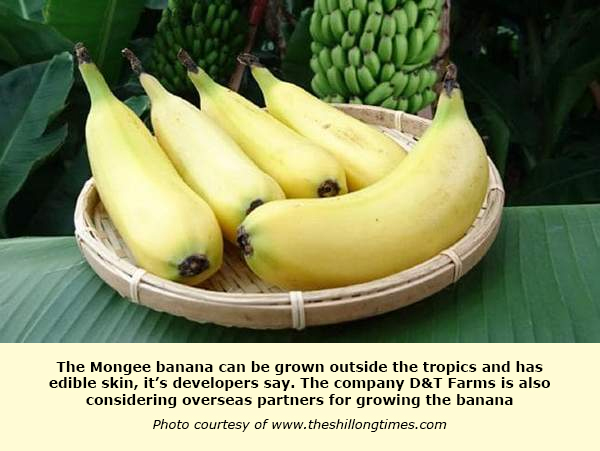A Japanese researcher has developed a banana that can be grown outside tropical or subtropical regions, and can be eaten in its entirety.

Named Mongee, meaning “super” or “incredible” in the Okayama Prefecture dialect, the banana was developed based on the Gros Michel, a variety that had been widely grown worldwide until about 50 years ago.
The bananas are made using a pesticide-free cultivation technique called “freeze thaw awakening,” which involves replicating a process observed in the Ice Age by soaking the banana plant near the roots in a special liquid.
Over a six-month period, the plants are slowly frozen by gradually decreasing the temperature of a freezer to minus 76 degrees Fahrenheit, followed by raising the temperature to 80 degrees Fahrenheit. At the end of the six-month period — only one-quarter of the time it takes for regular bananas to grow — the fruit is ripe. Their seedlings can produce identical fruits in the same short time through normal agriculture.
Although Mongee bananas can be cultivated outdoors, they are currently only greenhouse-grown to protect them from the typhoons that hit Japan in summer and early fall, and to increase the quality of the fruits.
The fruit was developed by Setsuzo Tanaka, technical development manager at the agricultural cooperative D&T Farm Inc. in Okayama, the capital of the prefecture of the same name. Tanaka said growing the bananas is not difficult, and anybody can do it with his company’s guidance.
“But we have set up farming lots for cultivation, and we provide cultivation guidance only to farmers who use those lots,” he said. The banana’s peel can be eaten because Gros Michel varieties’ skins are thin. Also, pests that attack the bananas do not exist in Japan, so they are grown pesticide-free, Tanaka said. “In addition, as D&T Farm uses bamboo charcoal instead of antibiotics for mericlone culture, the resulting seedlings have strong immunity,” he said.
Compared to bananas imported to Japan, Mongee bananas’ on-tree ripening period is longer, so the skins become riper and sweeter, Tanaka said. A mericlone is a cloned copy of the parent plant, made by taking pieces of the parent plant and growing new plants from the tissue.
To harvest seedlings for sale to farmers, D&T Farm grows the plants by mericlone culture. Using the seedlings, the purchasing farmers grow the plants by regular farming. “It is technically possible for farmers to use the freeze thaw awakening method with the seedlings, but that is not necessary,” Tanaka said.
Mongee banana supplies are currently limited to small batches of around 100 pounds of bananas sold locally every week, each banana selling for 648 yen, or about $5.90. Although volumes are limited, D&T Farm is currently shipping seedlings throughout Japan and increasing land under cultivation with the aim of exporting, Tanaka said. “Instead of only exporting bananas, we will probably think about a way of selecting partners in foreign countries to grow the fruits,” he said.
Meanwhile, D&T Farm is conducting research on over 230 plants, including applying its freeze thaw awakening method to coffee and papaya. Thanks to the freeze-thaw awakening method, coffee and papaya cultivation has become possible in Japan, Tanaka said.
“In order to efficiently produce and harvest them, we need to increase the number of their seedlings, so we are conducting research to that effect.”
Source: Richard Smith, Capital Press
